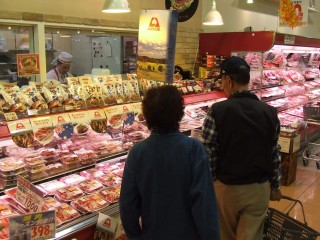 Concern is mounting within the export trade over a growing frozen and chilled beef stockpile in Japan, Australia’s largest volume and highest value export market.
Concern is mounting within the export trade over a growing frozen and chilled beef stockpile in Japan, Australia’s largest volume and highest value export market.
Lachie Hart, chairman of MLA’s Japan Market Taskforce says the 80,000 tonnes of beef currently held in storage is still modest in a historical context, having reached 250,000t at the height of the BSE crisis in the early 2000s.
“But looking at where it has been tracking over the past 12 to 18 months, the current stockpile is considerably higher than levels seen in recent times,” he said.
Industry forecasts suggest the stockpile will grow to 88,000t by the end of June.
Mr Hart, pictured below, agreed that logic would suggest that the presence of so much beef in cold storage had to put some pressure on import and wholesale prices for beef in Japan.
The expansion in the stockpile was mostly due to a slowdown in consumer demand as a direct consequence of the recent earthquake/tsunami/nuclear contamination crisis, followed more recently by a major food safety scare.
“We’ve been closely monitoring the retail uptake from Japanese consumers, and the trend is down. What we are seeing is that retail sales have held up for domestic beef; and are slightly increased for US imported beef, at the expense of Australian. The recent rise in the A$ is really starting to have an impact now in those areas,” Mr Hart said.
The food service segment (restaurants, hotels and other food outlets), was hardest hit following the earthquake, simply because consumers wanted to eat in the sanctuary of their own home, rather than socialise. That was most noticeable in the greater Tokyo area.
Food safety incident adds to concern
It was less evident in the western region of Kansei, but unfortunately that was the area which has been impacted most by the recent outbreak of E.coli bacterial contamination, which led to four recent deaths after people consumed raw beef in a restaurant.
While the product was definitely not Australian in origin, whenever such an event occurs, there is an immediate impact on beef consumption, generally.
“Particularly in Japan’s popular yakiniku/barbecue restaurants, sales have slumped by 25 percent since the food poisoning episode,” Mr Hart said.
“There is not yet any sign of recovery, as consumers remain wary. Certainly in the food service segment, the E.coli issue has had an even greater affect on beef consumption than the March earthquake events.”
“From an Australian exporters’ viewpoint, we have been maintaining prices to Japan, but every time we get prices up, it is obviously eroded by the higher exchange rate,” Mr Hart said.
“There is certainly a margin-squeeze happening from an exporters’ perspective into the Japanese market. Retailers in Japan are now very price-conscious buyers, and have been for a considerable time.”
So does the beef stockpile elevate the likelihood of a slowdown in importer demand for Australian beef until it returns to manageable levels?
“There is potential for that to occur,” Mr Hart said. “But the Japanese generally are not reactionary-type people. I don’t expect this will have a short-term significant impact, but it is more likely to simply prolong any delay in potential uptake.”
Given that Japan is now entering its traditionally slow summer beef consumption period, there may not be any significant downsizing of the stockpile until later in the year.
“The stockpile is certainly an area to be concerned about, but Japan still remains Australia’s most important export market by size and value,” Mr Hart said. “But it’s a matter that we have to monitor very carefully.”
Part of the MLA Japan Taskforce’s support role is to ensure that MLA’s marketing and promotion expenditure in the market is in-tune with latest influences on the market.
Mr Hart said it was likely that Australia’s Japan marketing emphasis could be adjusted a little, given what has happened since the tragic earthquake and Tsunami events of March. The actual budget size, itself, is likely to remain at pre-earthquake levels, but simply redistributed a little differently.
Part of that will include a support program designed to raise funds to be targeted at cattle producers in worst affected areas, where Australia could make a difference to people’s lives.
Sometimes that could include quite simple things.
“In one case, a local Mayor indicated that surrounding cattle farmers were desperate for hay. We’re now looking at how we may be able to get some Australian hay into the area,” Mr Hart said.
“It shows our industry supporting their industry, at a time of great need.”
-
Latest Japanese Ministry of Finance statistics show Japan’s chilled and frozen beef imports from Australia reached 31,061 tonnes in March, up 24pc on February figures. Imports from the US over the same period went from 6579t in February to 7788t, an increase of 18pc. Australia’s imported beef market share in Japan (year to date) currently stands at 69pc, down from 76pc for the same period last year. The US currently holds 19pc.
